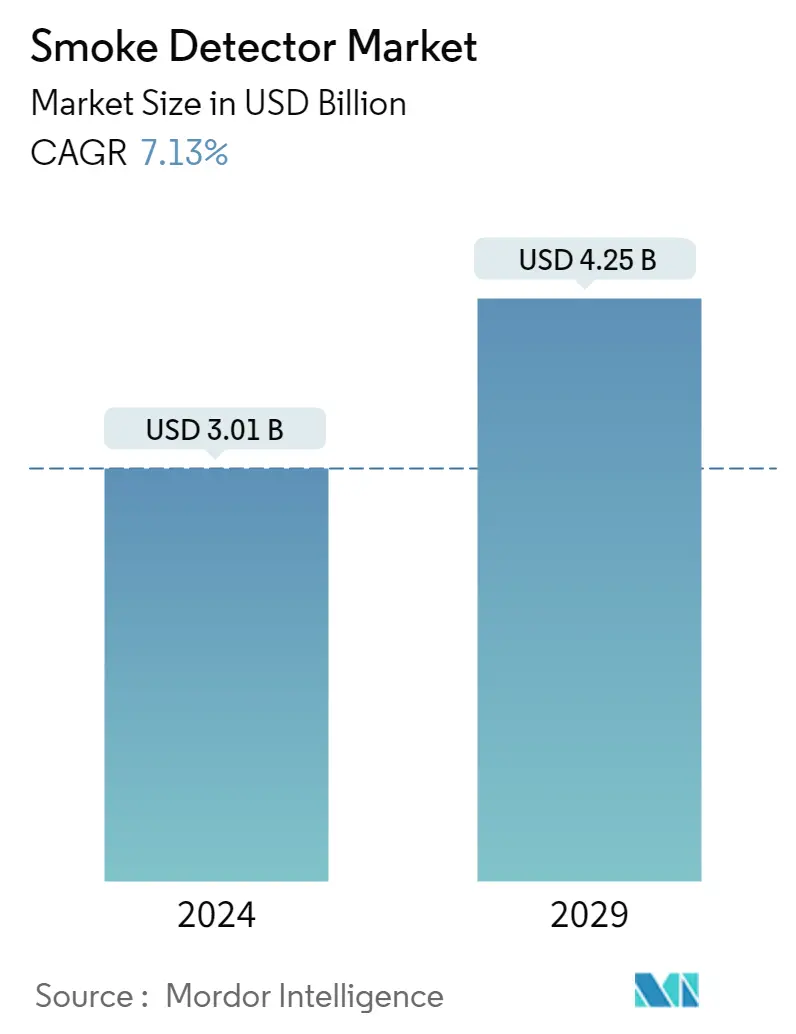Market Size of Smoke Detector Industry

| Study Period | 2019 - 2029 |
| Market Size (2024) | USD 3.01 Billion |
| Market Size (2029) | USD 4.25 Billion |
| CAGR (2024 - 2029) | 7.13 % |
| Fastest Growing Market | Asia-Pacific |
| Largest Market | North America |
| Market Concentration | Low |
Major Players
*Disclaimer: Major Players sorted in no particular order |
Smoke Detector Market Analysis
The Smoke Detector Market size is estimated at USD 3.01 billion in 2024, and is expected to reach USD 4.25 billion by 2029, growing at a CAGR of 7.13% during the forecast period (2024-2029).
The latest trend of IoT-enabled smart smoke-detecting service helps customers to prevent false alarms and offers enhanced security with advanced risk monitoring and instant action in any adversity. Customers can turn off the alarm via their IoT-enabled devices in case of false alarms, and the IoT-enabled system notifies the user about the need to change or replace batteries and other wearables. Also, the amalgamation of smartphones will drive the smoke detector market in the forecast period.
- A smoke detector is critical for the early detection of a fire in the residential, commercial, as well as industrial segments throughout the world. In a fire, smoke and deadly gases tend to spread farther and faster than heat, leading to death from inhalation of smoke and toxic gases. The growth of the commercial realty sector and IT industry to safeguard high-value assets such as data centers, manufacturing plants, powerhouses, buildings, and IT infrastructure is attracting the demand for fire safety equipment.
- Implementation of residential safety standards is driving the market. The increase in concern about fire safety has prompted the guidelines to be set by the US Fire Administration (USFA). Smoke detectors must now be installed inside every bedroom, outside each sleeping area, and on each level of the home, including the basement, and one carbon monoxide detector on each level and in each sleeping area. Photoelectric detectors tend to be more commonly used in homes, as they are quick to detect smoke coming from burning fabrics and furnishings.
- However, there are certain complications in installing smoke detectors. For instance, installing smoke detectors on a mounting surface that could be considerably cooler or warmer than the room, such as on an exterior wall or ceiling with poor insulation, is a key challenge for the market.
- One of the most emerging trends in the smoke detector market is the amalgamation of smartphones. Smartphone-connected smoke detectors are convenient since they can be easily disabled and work well at any place in the home that is prone to steam or cooking smoke, such as the kitchen or near bathrooms.
- Furthermore, the Internet of things (IoT) is being implemented in all electronic devices and instruments, from light bulbs and refrigerators to doorbells and garage doors. With almost anything now being controlled at the touch of a smartphone, it is not surprising that security integrators are incorporating the technology in smoke detectors. The growth of the commercial realty sector and IT industry to safeguard high-value assets such as data centers, manufacturing plants, powerhouses, buildings, and IT infrastructure is attracting the demand for fire safety equipment.
- The COVID-19 outbreak had an impact on the smoke detector industry. Owing to the quick spread of the virus, many organizations worldwide have been compelled to shut down, causing a demand-supply gap, a lack of workers, a delay in manufacture, and a postponement in the shipment of supplies and other parts of smoke detectors. On the other hand, the restoration of production activity has culminated in a large increase in the implementation of smoke detectors in the residential, healthcare, and production end-use industries, which is expected to contribute to market expansion.
Smoke Detector Industry Segmentation
Smoke detectors are employed to detect smoke in the surrounding environment. In case of a fire emergency, the system can trigger alarms and activate safety systems. The systems come in different types depending on the use and environment used, where both photoelectric and ionization detectors are effective smoke sensors. These systems are really important and are being employed in many commercial and residential areas.
The smoke detector market is segmented by technology type (ionization smoke detection device, photoelectric smoke detection device, beam smoke detection device), end-user industry (commercial, residential, transportation & logistics, oil & gas), and geography.
| By Technology Type | |
| Ionization Smoke Detection Device | |
| Photoelectric Smoke Detection Device | |
| Beam Smoke Detection Device |
| By End-user Industry | |
| Commercial | |
| Residential | |
| Transportation & Logistics | |
| Oil & Gas | |
| Other End-user Industries |
| Geography | ||||||
| ||||||
| ||||||
| ||||||
|
Smoke Detector Market Size Summary
The smoke detector market is poised for significant growth, driven by the increasing emphasis on fire safety across residential, commercial, and industrial sectors globally. The integration of IoT technology into smoke detectors is a notable trend, enhancing security through advanced risk monitoring and the ability to manage alarms via smartphones. This technological advancement is expected to bolster market expansion, as it offers users greater control and convenience, particularly in preventing false alarms. The demand for smoke detectors is further fueled by the growth of the commercial realty sector and the IT industry, which require robust fire safety measures to protect valuable assets. Additionally, stringent residential safety standards and regulations, particularly in developed regions, are contributing to the market's upward trajectory.
The market landscape is characterized by a high level of competition, with key players like Honeywell International Inc., ABB Group, and Siemens AG focusing on product diversification and innovation to enhance their market presence. The COVID-19 pandemic initially disrupted supply chains and production, but the subsequent recovery has led to increased adoption of smoke detectors in various sectors, including residential, healthcare, and manufacturing. Regulatory mandates in countries such as the United States, Canada, and Japan have further propelled market growth by requiring smoke detectors in new buildings and residential units. As awareness of fire safety and the dangers of carbon monoxide increases, the market is expected to continue its expansion, supported by ongoing technological advancements and regulatory compliance.
Smoke Detector Market Size - Table of Contents
-
1. MARKET DYNAMICS
-
1.1 Market Overview
-
1.2 Market Drivers
-
1.2.1 Increasing Concerns for Fire Safety
-
1.2.2 Implementation of Residential Safety Standards
-
1.2.3 Innovation in Sensor Technology
-
-
1.3 Market Restraints
-
1.3.1 Complications Regarding Installation of Smoke Detectors
-
1.3.2 Higher Costs of Replacements of Traditional Smoke Detectors with Smart Smoke Detectors
-
-
1.4 Industry Value Chain Analysis
-
1.5 Industry Attractiveness - Porter's Five Forces Analysis
-
1.5.1 Threat of New Entrants
-
1.5.2 Bargaining Power of Buyers
-
1.5.3 Bargaining Power of Suppliers
-
1.5.4 Threat of Substitute Products
-
1.5.5 Intensity of Competitive Rivalry
-
-
-
2. MARKET SEGMENTATION
-
2.1 By Technology Type
-
2.1.1 Ionization Smoke Detection Device
-
2.1.2 Photoelectric Smoke Detection Device
-
2.1.3 Beam Smoke Detection Device
-
-
2.2 By End-user Industry
-
2.2.1 Commercial
-
2.2.2 Residential
-
2.2.3 Transportation & Logistics
-
2.2.4 Oil & Gas
-
2.2.5 Other End-user Industries
-
-
2.3 Geography
-
2.3.1 North America
-
2.3.1.1 United States
-
2.3.1.2 Canada
-
-
2.3.2 Europe
-
2.3.2.1 Germany
-
2.3.2.2 France
-
2.3.2.3 United Kingdom
-
2.3.2.4 Rest of Europe
-
-
2.3.3 Asia-Pacific
-
2.3.3.1 China
-
2.3.3.2 Japan
-
2.3.3.3 South Korea
-
2.3.3.4 Rest of Asia-Pacific
-
-
2.3.4 Rest of the World
-
2.3.4.1 Latin America
-
2.3.4.2 Middle East & Africa
-
-
-
Smoke Detector Market Size FAQs
How big is the Smoke Detector Market?
The Smoke Detector Market size is expected to reach USD 3.01 billion in 2024 and grow at a CAGR of 7.13% to reach USD 4.25 billion by 2029.
What is the current Smoke Detector Market size?
In 2024, the Smoke Detector Market size is expected to reach USD 3.01 billion.

